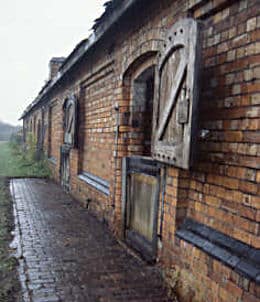The canal people and the canal horses
It needs two people to work a horse drawn boat, one to steer and keep the boat in deep water and the other to drive the horse. A third hand to set the locks would be a bonus but the income possible from one boat was rarely sufficient to pay for more than a crew of two. Very often that was a man and his wife, and their children would fulfil the role of unpaid extra crew.
Some horses would work by themselves without a driver, would ‘backer’ as the boating expression put it, but it was a risky business and someone had to be ready to leap ashore anytime they met another horse boat coming the other way. Then, according to a complicated set of rules about who had right of way, one horse would be slowed up so that the towline went slack and the other horse could step over it without stopping. The cotton rope would sink and be dragged along the bottom of the canal whilst the boat with right of way was pulled over it. Then the other boat could get going again. That was what was supposed to happen according to the rules. In practice after one horse had crossed the other’s towline it would be driven on smartly again and both boats proceeded at full speed. The drum-tight line to the outside boat was then flicked up and over the cratch and mast and along the top-planks before being caught and lifted over the watercan, chimney and helm by the inside boat’s steerer.
But it was a nervous business and any mistake could be disastrous with all that momentum in opposition, travelling at double horse speed. But then again the boatman had no idea what the line might snag on with the underwater option so there was an element of dangerous gamble either way.
Each working canal boat needed a horse or mule to pull it, (or perhaps a pair of donkeys) and a fly boat working non-stop might need two or three in a day. The number of animals involved was enormous and the number of workmen needed to keep all this horseflesh shod, fed and healthy was equally large. A hard worked canal horse had to be fed well and regularly with high energy food and all the corn, crushed oats and chopped hay had to be prepared and available at the provender stores all over the system.
Every boat horse needed a stall in a stable at each end of every day’s journey, for a hot tired horse cannot be put out in a cold field for the night, so every regular stopping place, whether warehouse, wharf or canalside pub had to be equipped with stabling. Larger establishments employed ostlers to look after the change horses and sick horses, and they would keep the stable mucked out and ready for use for their boating customers. A boat horse could wear out a set of shoes in four to six weeks so an army of blacksmiths had to be on hand as well to keep the industry running.
The canal world was narrow but it was very long and the horse drawn transport industry that it supported was large and important, employing thousands of people and thousands of horses. But the physical evidence of this historic industry is vanishing fast, sometimes by a conscious process of modernisation but very often by innocent ignorance, by the simple non-recognition of the evidence by those charged with the maintenance of the waterways.
There has been another half a century of motor and pleasure boats in which to forget the facts and first hand experience of working loaded horse boats is now necessarily getting rarer.
All materials and images © Canal Junction Ltd. Dalton House, 35 Chester St, Wrexham LL13 8AH. No unauthorised reproduction.
About
| Terms
| Privacy |
Returns |
Sitemap
| Contact Us
Web Hosting & Development
With over 800 pages, this website uses cookies to record visitor behaviour using Google Analytics. More information on Privacy Page. Page last updated: 17/10/2025.



Back to Menu....
Narrowboats & Barges >>
Canal Heritage >>